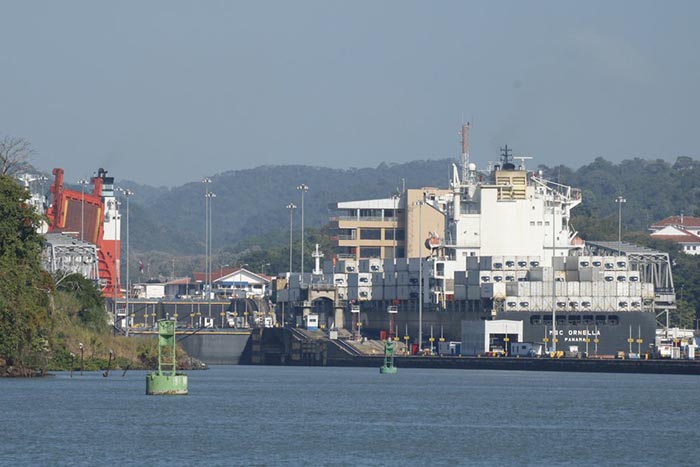Peter Leach at JOC.com reports on the financial impact of construction problems of the Panama Canal Expansion.
When the Panama Canal’s third set of larger locks open to commercial traffic this spring, the massive expansion project will be more than a year and a half behind the original target date of October 2014 and an estimated $150 million over the $5.25 billion budget set 10 years ago.
Ships will be run through the new locks by the end of April to test their performance, so if they perform as required by the canal authority’s contract with the consortium building them, they may be opened to commercial traffic in May.
The delays and the cost overruns have been a continuing headache for Panama Canal Administrator Jorge Quijano.
“It’s the biggest construction job ever in Panama, done right now at the same time as we’re running a successful operation. That has headaches of its own,” Quijano said in an interview with JOC.com. “So it’s a stressful situation sometimes, but I live a day at a time, always focusing on the future. That keeps me upbeat.”
The delays have strained relations between the Canal Authority and the engineering consortium that is building the new locks, which is known as GUPC, Grupo por el Canal. GUPC first ran into problems when the cement it was pouring for the locks did not meet contractual standards for durability of 100 years. Then it was hit by a six-day strike in 2012, and most recently by leaks in one of the eight sills that underlie the huge gates that will slide shut and hold the water that is being pumped in or out as the level lifts or lowers ships to the next canal level.
Although only one of the eight sills in the locks was leaking, the contractor decided to reinforce six of the eight sills, three on the Atlantic locks and three on the Pacific locks, which has required importing 832 steel reinforcement bars, or rebars, totaling 18 kilometers (11 miles) in length and the drilling equipment to install them.
“So that added more work since August,” Quijano said. “We have to wait until they finish the work and we begin retesting those seals to make sure the correction has been effective.”
The rebuilding of the sills should be completed by the end of January. “Then from there on we should start on one of the locks, filling water, to start the testing to make sure that the repairs and reinforcements were done correctly.”
GUPC has filed claims for $1.6 billion in cost overruns under its $3.12 billion contract with the canal authority. The consortium has already been awarded some of this by an arbitrator and the remainder is still in arbitration. “”We have paid them about $280 million for claims,” Quijano said. “Assuming that there will be no additional claims that they would win at one of the levels, then they’re looking at about $300 million worth of claims at this time.”
Part of this is covered by the $100 million to $200 million that had been budgeted for contingencies in the original $5.25 billion project cost, but the rest will exceed that target. “That puts us over the $5.25 billion budget, somewhere around $5.4 billion right now,” Quijano said.
The canal authority can impose hefty penalties if the locks don’t meet specified targets, and Quijano stands ready to impose them if GUPC cannot meet the performance standards. “There is a penalty for having a non-performing water flow, because that has a lifetime effect on the locks, and that’s why it is so critical and that’s why the penalty is so high.”
The water has to “equalize” or flow into and out of the locks to the level outside with 10 minutes or within 17 minutes if the water-saving basins are utilized. “So if they are off from those maximums, we allow them one more minute, and then from there on we start counting for the next minute $100 million,” the canal administrator said.
The penalties are similar if the gates don’t perform up to snuff. Under the contract the gates have a maximum limit of five minutes to open or to close. “If it takes more than that for the next minute it will grow another $100 million. So you have actually $200 million as part of the game here over the acceptance testing that will take place.”
Contact Peter Leach at peter.leach@ihs.com and follow him on Twitter: @petertleach.
